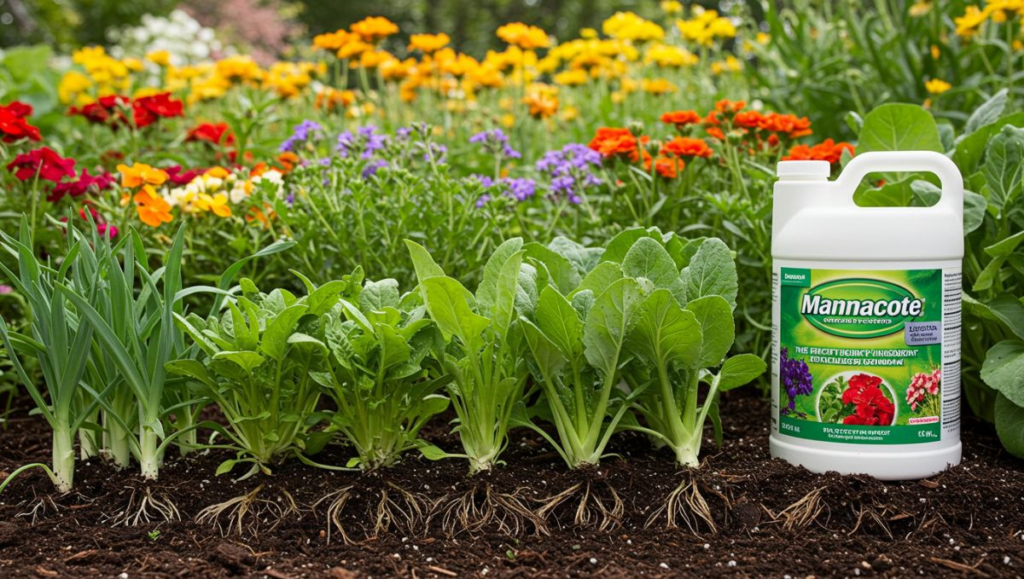
In gardening and agriculture, the right nutrition is key to plant health and growth. However, traditional fertilizers often offer a quick release of nutrients, which can result in imbalances, nutrient waste, and higher costs. This is where Mannacote comes in—a slow-release controlled-release fertilizer (CRF) that ensures plants receive a steady supply of essential nutrients throughout their growth cycle. This article explores the many benefits, applications, and detailed usage of Mannacote, making it the go-to solution for garden enthusiasts, landscapers, and farmers alike.
What Is Mannacote?
Mannacote is a type of controlled-release fertilizer (CRF) that provides essential nutrients to plants over an extended period, usually from 3 to 6 months, depending on environmental conditions. Traditional fertilizers often release nutrients all at once, leaving plants vulnerable to nutrient overload or deficiency. On the other hand, Mannacote’s unique polymer coating ensures that the nutrients are released slowly, aligning with the plant’s growth needs over time. This results in a more consistent and balanced supply of nutrients, leading to healthier plants and more efficient use of fertilizer.
The controlled release of Mannacote is tailored to the plant’s growth cycle, providing nutrients exactly when they are needed. The fertilizer can be used in a variety of settings, from home gardens to commercial agricultural operations, providing flexibility for different types of plants and growing conditions.

How Does Mannacote Work?
Mannacote’s key feature is its polymer-coated granules. The polymer coating is designed to control the release of nutrients based on environmental factors such as temperature and moisture levels. The release of nutrients is temperature-responsive: when the soil temperature increases, the polymer coating becomes more permeable, allowing nutrients to gradually diffuse out. In cooler temperatures, the release is slower, reflecting the plant’s lower nutrient requirements at that time.
This mechanism ensures that plants receive the nutrients they need at every stage of their growth cycle. For example, during the peak growing season, when plants require more nutrients, the polymer coating allows for faster nutrient release. Conversely, during cooler periods, the release rate slows down, preventing excess nutrients from leaching into the environment.
Also Read: Thriftyevents.net: Your Go-To Platform for Affordable Event Planning
Key Benefits of Using Mannacote
1. Consistent Nutrient Availability
One of the most significant benefits of using Mannacote is the consistent nutrient supply. Many traditional fertilizers provide a quick burst of nutrients that plants may not be able to utilize fully. Mannacote, however, ensures that plants receive a steady and reliable supply of nutrients over an extended period. This consistency supports healthy plant growth, prevents nutrient deficiencies, and promotes overall plant vitality.
2. Reduced Nutrient Leaching
Nutrient leaching occurs when excess fertilizers are washed away by water, potentially contaminating groundwater and waterways. This is a common problem with traditional fertilizers, as they often release nutrients too quickly. Mannacote’s controlled release minimizes nutrient leaching, ensuring that nutrients stay in the soil and are available to the plants for longer periods. This not only helps reduce environmental impact but also ensures more efficient use of fertilizer.
3. Lower Environmental Impact
Using Mannacote leads to fewer fertilizer applications over time, which reduces the carbon footprint associated with fertilizer production, transportation, and application. Additionally, the risk of nutrient runoff is reduced, contributing to cleaner water and healthier ecosystems. Mannacote’s controlled-release technology also reduces the buildup of salts and other residues in the soil, promoting better soil health in the long run.
4. Cost-Effectiveness
Although Mannacote may have a higher upfront cost compared to traditional fertilizers, it proves to be more cost-effective in the long run. Because it lasts longer and requires fewer applications, the overall cost of fertilization is reduced. For large-scale farms, landscaping projects, and home gardens, the reduced labor and material costs make Mannacote a budget-friendly choice in the long term.
5. Enhanced Plant Health
The slow, controlled release of nutrients promotes strong root development and encourages plants to grow more vigorously. Healthy plants are better equipped to resist pests and diseases, resulting in less need for chemical interventions. Additionally, plants that receive a steady supply of nutrients have improved overall health, making them more resilient in the face of environmental stressors.
Applications of Mannacote
Mannacote is a versatile fertilizer that can be applied in various settings. Below are some of the primary applications of this product:
1. Home Gardening
Home gardeners can greatly benefit from the use of Mannacote in their gardens. Applying Mannacote to garden beds, lawns, and potted plants ensures that they receive the right amount of nutrients for optimal growth. Because it lasts for several months, it reduces the need for frequent fertilization, saving time and effort. Additionally, it’s an excellent option for beginners or those looking for an easy-to-use, low-maintenance fertilizer.
Mannacote works well for a variety of plants, including flowers, vegetables, shrubs, and trees, providing consistent nourishment that helps them thrive throughout the growing season. Whether you’re planting perennials or maintaining an ornamental garden, Mannacote offers a simple and effective solution for your fertilization needs.
2. Commercial Agriculture
For commercial farmers, Mannacote offers an efficient and cost-effective solution for boosting crop yields. Farmers can apply Mannacote to large-scale crops such as fruits, vegetables, grains, and flowers, benefiting from its slow-release properties. The reduction in labor and material costs, combined with improved crop quality, makes Mannacote a great choice for commercial agricultural operations.
Its versatility allows it to be used on a wide range of crops, making it a flexible option for different farming needs. Whether you’re growing organic produce or conventional crops, Mannacote can support your operation’s fertilization program.
3. Landscaping
Mannacote is an ideal fertilizer for landscapers who want to maintain vibrant, healthy landscapes with minimal maintenance. Landscapers can apply Mannacote to newly planted shrubs, trees, flowers, and turf to ensure they receive consistent nutrition during the establishment phase. It’s particularly useful in landscaping projects where plants are newly introduced or where long-term growth is essential.
By reducing the need for frequent fertilization, Mannacote helps landscapers achieve lush, healthy landscapes with fewer applications, saving time and money in the process.
How to Use Mannacote
Application Rates
The recommended application rate of Mannacote depends on factors like soil type, plant species, and the desired release duration. Generally, it’s best to apply the fertilizer according to the specific needs of your plants and the manufacturer’s guidelines. Soil tests can help determine the optimal application rate, ensuring that your plants receive the appropriate amount of nutrients for healthy growth.
Timing of Application
Mannacote should be applied at the beginning of the growing season to coincide with the plant’s peak nutrient uptake phase. Depending on the plant’s growth cycle, a second application may be needed midway through the season to continue providing essential nutrients. Proper timing ensures that nutrients are available when the plant needs them most, supporting vigorous growth throughout the year.
Incorporation into Soil
Mannacote can be applied to the surface of the soil or mixed into the soil for better distribution. When applying it to garden beds or flower pots, gently work the granules into the soil for even nutrient distribution. After application, water the area thoroughly to activate the release process. The moisture helps the polymer coating to begin releasing nutrients into the soil.
Comparing Mannacote to Traditional Fertilizers
Mannacote’s controlled-release properties offer several distinct advantages over traditional fertilizers:
| Feature | Mannacote (Controlled-Release) | Traditional Fertilizers (Soluble) |
| Nutrient Release | Gradual over 3–6 months | Immediate, often rapid |
| Leaching Risk | Low | High |
| Burn Risk | Minimal | High |
| Application Frequency | 1–2 times per season | Multiple times per season |
| Labor Requirement | Low | High |
| Nutrient Use Efficiency | High | Moderate to Low |
Mannacote offers a more efficient and environmentally friendly alternative to traditional fertilizers, which is especially beneficial for large-scale applications.
Environmental Sustainability and Mannacote
Mannacote’s controlled-release technology not only benefits plants but also the environment. By reducing the frequency of fertilizer applications, Mannacote helps lower the overall carbon footprint associated with fertilizer production and transportation. The efficient release of nutrients also prevents nutrient leaching into nearby water sources, reducing the risk of environmental pollution. Additionally, Mannacote helps maintain soil health by preventing the accumulation of harmful salts and other residues that can degrade the soil structure.
Also Read: Calamariere: Understanding the Unique Italian Delight
Frequently Asked Questions (FAQs)
Is Mannacote safe for all types of plants?
Yes, Mannacote is suitable for a wide range of plants, including vegetables, fruits, flowers, and ornamental plants. However, it’s essential to follow the recommended application rates for each plant type.
Can Mannacote be used in organic gardening?
Mannacote is a synthetic fertilizer and may not be approved for use in organic farming. Always check with your organic certification body before using it in organic gardens.
How does Mannacote compare to other controlled-release fertilizers?
Mannacote’s unique polymer coating offers more efficient nutrient release compared to many other CRFs on the market, providing a more consistent and longer-lasting supply of nutrients.
Can Mannacote be used in hydroponic systems?
Mannacote is designed for soil-based applications and may not be suitable for hydroponic systems. Hydroponics require fertilizers specifically formulated for water-based environments.
What are the storage requirements for Mannacote?
Mannacote should be stored in a cool, dry place, away from direct sunlight and moisture. Properly sealing the container will help maintain its effectiveness.
Conclusion
Mannacote is a game-changer in the world of plant nutrition. Its controlled-release properties provide plants with a steady supply of essential nutrients, ensuring healthy growth, improving nutrient use efficiency, and minimizing environmental impact. Whether you’re a home gardener, commercial farmer, or landscaper, Mannacote offers a sustainable, cost-effective solution to achieving vibrant, healthy plants.



